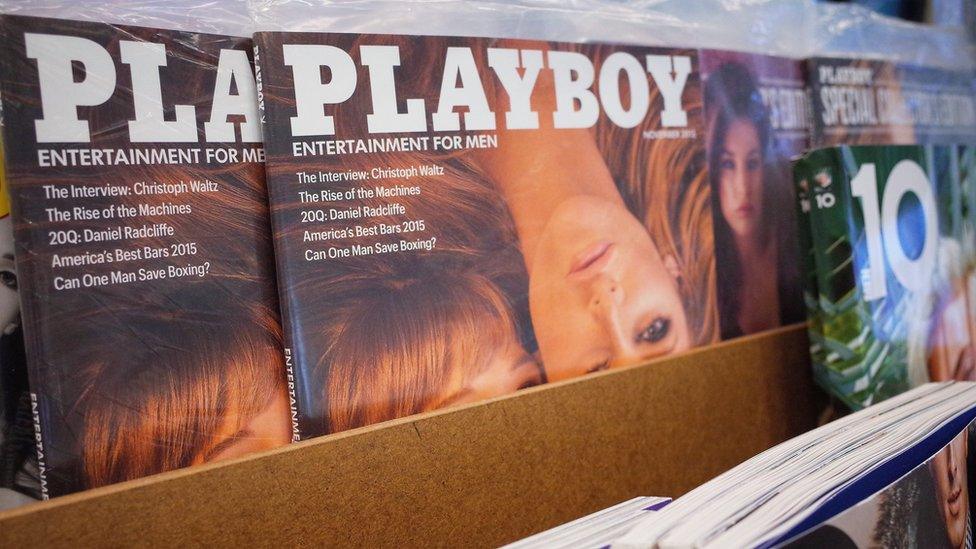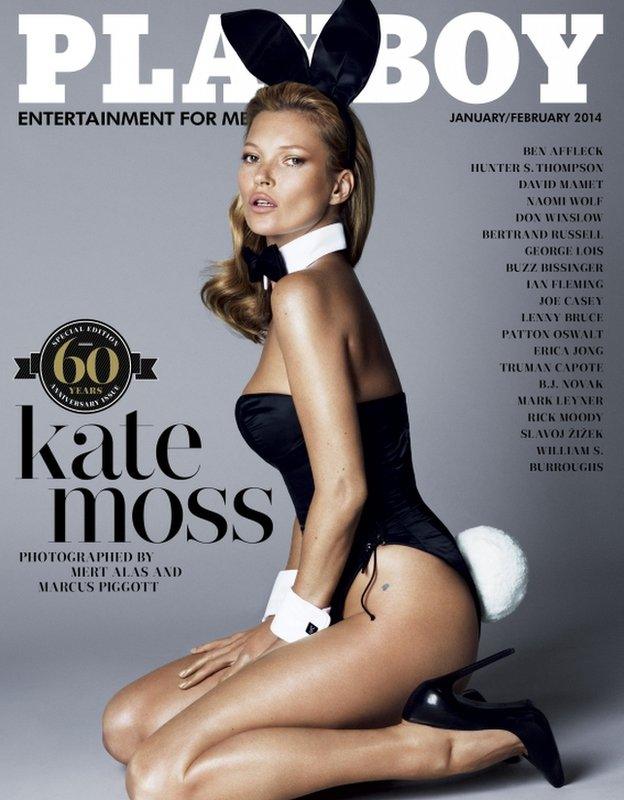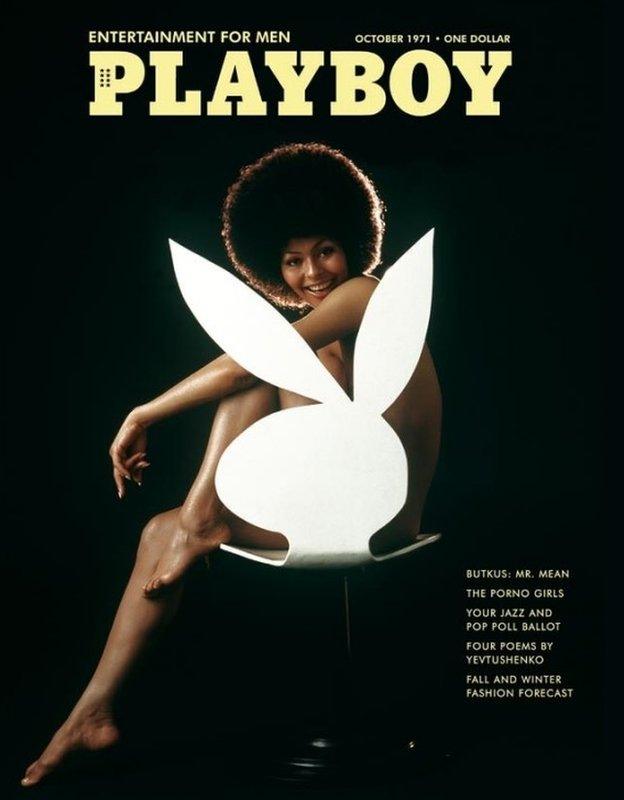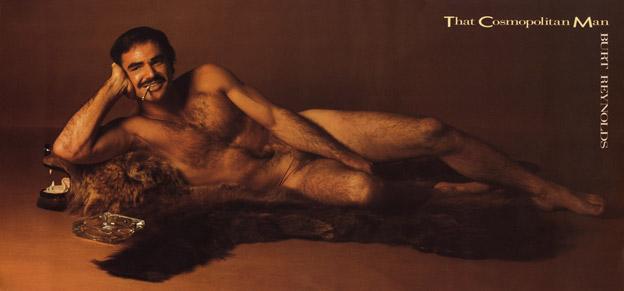Why America loved Playboy
- Published

Playboy magazine is stopping publishing pictures of totally nude women because the internet has made them outdated, its US owners say. It's a break with a 62-year format that has had a significant impact on American culture.
Every month since 1953, fold-out spreads of fully nude women have filled Playboy.
The glossy adult men's magazine boasts a plethora of celebrity conquests in its portfolio. Madonna, Sharon Stone and Naomi Campbell were photographed at the peak of their fame. Kate Moss posed for its front cover in a bunny outfit. Lindsay Lohan and Pamela Anderson have also graced it.
The magazine may have offended some who see it as sexist and demeaning to women, but the idea of Playboy dispensing with nudity would once have been unthinkable.
But in March 2016, that will happen. "You're now one click away from every sex act imaginable for free. And so it's just passe at this juncture," Playboy chief executive Scott Flanders is quoted by the New York Times as saying.
The redesigned Playboy will still feature "sexy, seductive pictorials of the world's most beautiful women," but full nudity will be banished.

Kate Moss on the cover 60th anniversary issue of Playboy

Marilyn Monroe on the December 1953 debut issue
It ends a cultural phenomenon that was a rite of passage for a generation of American men - an illicit thrill in adolescent bedrooms or garden sheds - and helped spark America's sexual revolution.
From its beginnings editor-in-chief Hugh Hefner founded the magazine on full nudity. Marilyn Monroe famously appeared on the magazine's first cover and centrefold.
Hefner didn't hide the magazine's intentions.
"If you're a man between the ages of 18 and 80, Playboy is meant for you," he wrote in the first issue. "We want to make it clear from the very start, we aren't a 'family magazine.' If you're somebody's sister, wife or mother-in-law and picked us up by mistake, please pass us along to the man in your life and get back to your Ladies Home Companion."
He also described the "pleasure-primer" he wanted to create.

Playboy founder Hugh Hefner and third wife and former Playboy Playmate of the Month, Crystal
"Most of today's 'magazines for men' spend all their time out-of-doors - thrashing through thorny thickets or splashing about in fast-flowing streams. We enjoy mixing up cocktails and an hors d'oeuvre or two, putting a little mood music on the phonograph, and inviting in a female acquaintance for a quiet discussion on Picasso, Nietzsche, jazz, sex," it said.
The 50,000 copies - which were sold for 50 cents each - flew off the shelf.
Dian Hanson, author of a six-volume history of men's magazines and an editor for Taschen, says Hefner tapped into a new consumer attitude that emerged at the end of World War Two.
"America came out the war relatively unscathed, it did not suffer like Europe. Many young men didn't see battle but had experienced more adventurous things, more nudity, and wanted something different when they came back.
"It wasn't the first nude magazine, but rather than showing a macho Hemingwayesque way of life that many men didn't relate to, it showed scrawny intelligent guys they didn't have to be rough, tough guys to be a playboy. It was a nerds' way to sexuality - which is what Hefner himself did to get girls," she says.

Playboy's logo showing a rabbit head wearing a bow tie was apparently designed in 10 minutes
During Playboy's heyday, readers could plausibly claim they read it for its writing and journalism.
The magazine published stories by Jack Kerouac, Joseph Heller, Haruki Murakami and Margaret Atwood among others, and interviewed culturally and politically significant figures such as Frank Sinatra, Malcolm X and Jimmy Carter.
But nudity was always a big selling point of the magazine, which attracted or coaxed well-known female public figures into gracing its pages.
"Some of the pictures were pretty amazing and became pop culture references. Naomi Campbell in her white trap outfit. American actress Bo Derek," says Hanson.
"Esquire magazine was the template. They had painted pin-ups but they didn't have nudes. Hefner basically reconfigured a magazine made by older men to fit a younger man's need, and then took it a step further," she says.

Darine Stern on the cover of the October 1971 edition

October 2015 college issue of Playboy
Playboy's circulation peaked at more than 7.16m copies in 1972, with a quarter of all American male college students reportedly reading it in the 1970s. It literally explained sex to a generation of American men.
The success of Playboy magazine gave way to the rise of the Playboy lifestyle, allowing Hefner to build a Playboy mansion, create Playboy clubs with cocktail waitresses decked out in Bunny outfits and endless Playboy merchandise.
The rise of feminism led to some criticism that women were being objectified. US feminist and journalist Gloria Steinem worked undercover at the New York Playboy Club to write "A Bunny's Tale," which showed conditions waitresses faced in 1963.
But Hanson argues Playboy magazine was a respectable, even desirable, place for women to "show themselves off". "It was a poor girl's pageant, grandmothers would approve," she says.
It also ushered in a new era of women's magazine publishing. Cosmopolitan famously published a nude photo of Burt Reynolds as a centrefold in 1972 and the debut issue of Playgirl appeared in June 1973.
More raunchy US competitors like Hustler and Penthouse soon arrived, while so-called lad mags such as Maxim, Stuff and FHM followed later.
But it was the internet era - which made pornography more readily available - which the magazine blamed for the circulation plummeting to its current 800,000.
The company no longer makes most of its money from its racy photos. Instead it's made from licensing its logo on merchandise.
Playboy's website has already banished nudity, and web traffic has quadrupled.
Magazine executives hope the print version will follow in its footsteps.
But Hanson isn't convinced. "Unless a new breed of hipster manages to get retro magazines back in fashion like vinyl records, without nudity Playboy is a limping beast," she says.

More from the Magazine


Subscribe to the BBC News Magazine's email newsletter, external to get articles sent to your inbox.